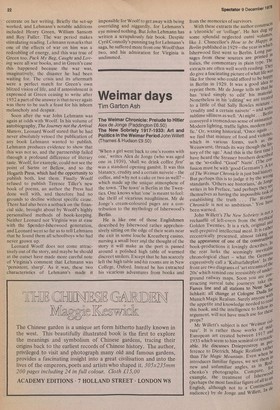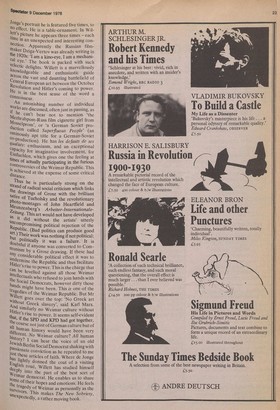Weimar days
Tim Garton Ash
The Weimar Chronicle: Prelude to Hitler Alex de Jonge (Paddington £6.50) The New Sobriety 1917-1933: Art and Politics in the Weimar Period John Willett (Thames & Hudson £9.50) 'When a girl went back to one's rooms with one,' writes Alex de Jonge (who was aged one in 1939), 'shall we drink coffee first' was a standard opening gambit. It was this blatancy, crudity and a certain naivete — the coffee, and why not a cake or two as well? — which made up the unique atmosphere of the town. 'The town' is Berlin in the Twenties. One knows what 'one' is meant to feel: the thrill of vicarious naughtiness. Mr de Jonge's cream-coloured pages are a contribution to the mythology of Isherwood's Berlin.
He is like one of those Englishmen described by Isherwood rather apprehensively sitting on the edge of their seats near the exit in some Touche Kreuzberg casino, nursing a small beer an,d the thought of the story it will make as the port is passed around a polished high table of warmed discreet smilers. Except that he has scarcely left the high table and his rooms are in New College, Oxford. Instead he has extracted his vicarious adventures from books and from the memories of survivors. With these extracts the author constructs a 'chronicle' or 'collage'. He has dug up some splendid neglected outré volumes, like J. Chancellor's How to be HapPY Berlin published in 1929 — the year in whie" Isherwood first went to Berlin. Long passages from these sources are printed o' italics, the commentary in plain typeThe extracts are often well worth reading. They do give a fascinating picture of what life was like for those who could afford to be haPPY in Berlin in 1929. It was a good idea icj reprint them. Mr de Jonge tells us that be has 'tried simply to edit' his material. Nonetheless in his 'editing' we are treated to a little of that Sally Bowles mixture 'crudity and a certain naivete' — and some sublime silliness as well. 'At night. . .Be,r1„in conveyed a tremendous sense of anirnati07 Modern lighting, traffic lights, rnodern tray fie.' Or, waxing historical, 'Once again we find that mixture of food and violence, which in various forms, such as the Weisswurst, threads its way though the his; tory of the age.' And this is the first tilted.' have heard the Strasser brothers describe as the 'so-called "Good" Nazis', (The Oil; fusion must be with 'good Germans'). of The Weimar Chronicle is just bad historY' But perhaps this is to judge it by the wr011 standards. 'Others see historians,' de .1°g...writes in his Preface, 'and perhaps they sel. themselves as having the impossible tasic„°,. establishing the truth . . . The VW Chronicle is not so ambitious.' You have been warned. John Willett's The New Sobriety is Vt,,ai rechauffe of left-overs from the mYtd Golden Twenties. It is a rich, original 1111. well-prepared intellectual meal. it is rati'e eccentrically presented, almost taking ic'?o the appearance of one of the cxxistructiia book-productions it lovingly describes. the rear lurks the seemingly inevitah': chronological chart — what the Gertnahl3e expressively call a 'Kulturfahrplan'.10 front are two diagrams of 'art streams or t120s' which remind one irresistibly of U11 ground railway maps. Soon you are e°11e structing surreal tube journeys: take Fasves line and all stations to Neue Sart lichkeit: all change at Cologne Dada Munich Magic Realism. Surely anyone wi d the appetite and knowledge needed torea_ this book, and the intelligence to follow 11: argument, will not have much use for these props? ‘.dl: Mr Willett's subject is not Weimar Cli flue'. It is rather those works of European art created between 1917 a k, 1933 which seem to him seminal or rerilare, able. He discusses Dnieprostroy 13,rner ference to Dietrich, Magic Realism rat"be than The Magic Mountain. Even When introduces familiar figures, we see them new and unfamiliar angles, as in gclror chenko's photographs. Compare, to( example, the treatment of Isherw00 (perhaps the most familiar figure of all t°_, English, although not to a Continenta,e' audience) by de Jonge and Willett. In ° Jonge's portrait he is featured five times, to no effect. He is a table-ornament. In Wil lett's picture he appears three nines — each time in an unexpected and interesting connection. Apparently the Russian film maker Dziga-Vertov was already writing in the 1920s: am a kino-eye, I am a mechanical eye.' The book is packed with such eclectic delights. Willett is a marvellously knowledgeable and enthusiastic guide across the vast and daunting battlefield of Central European art between the October Revolution and Hitler's coming to power. He is in the best sense of the word a connoisseur. . An astonishing number of individual works are discussed, often just in passing, as if he can't bear not to mention 'the Meahrabpom-Russ film cigarette girl from Mcgsselprom', or 'a German Soviet production called Superfluous People' (an nulinously apt title for a German-Soviet co-production). He has les defauts de ses qualizes: enthusiasm, and an exceptional capacity for imaginative involvement, for Einfuehlen, which gives one the feeling at times of actually participating in the furious controversies of the Weimar Republic. This IS achieved at the expense of some critical distance. Thus he is particularly strong on the strand of radical social criticism which links the drawings of Grosz with the brilliant satire of Tucholsky and the revolutionary Photo-montages of John Heartfield and Meunzenberg's Arbeiter-Internationale Zeitung. This art would not have developed as it did without the artists' utterly uncompromising political rejection of the Republic., (Bad politics can produce good art.) Their work was nothing if not political: but politically it was a failure. It is doubtful if anyone was converted to Communism by a Grosz drawing. If these had any considerable political effect it was to undermine the Republic and thus facilitate Hitler's rise to power. This is the charge that can be levelled against all those Weimar intellectuals who refused to join hands with the Social Democrats, however dirty those hands might have been. This is one of the tragedies of the Weimar Republic. But Mr Willett goes over the top: 'No Greek art Without Greek slavery', said Karl Marx. And similarly no Weimar culture without Hitler's rise to power. It seems self-evident that, if the SPD and KPD had got together, Me course not just of German culture but of all human history would have been very different. No Weimar culture? All human history? I can hear the voice of an old Jewish Berlin Social Democrat shaking with passionate conviction as he repeated to me Lust these articles of faith. Where de Jonge as lightly donned the coat of a visiting English roué, Willett has studied himself deeply into the part of the best sort of Weimar democrat. He enables us to share smile of their hopes and emotions. He feels the tragedy of Weimar as personally as the survivors. This makes The New Sobriety, unexpectedly, a rather moving book.















































 Previous page
Previous page